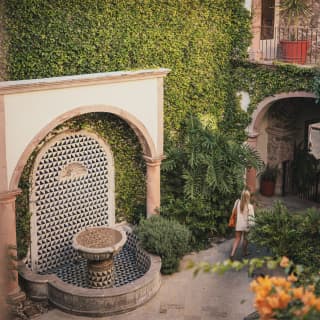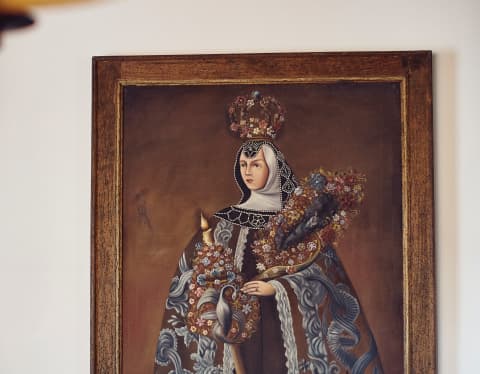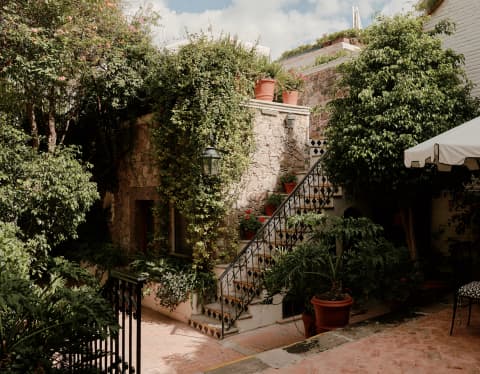Reading the Room: Casa de Sierra Nevada
Reading the Room: Casa de Sierra Nevada

At Casa de Sierra Nevada in San Miguel de Allende, hidden gems of Mexican craftsmanship are nestled in every corner. Made up of six individual casas dating back to the 17th and 18th-century, step inside and discover the history and handicrafts hidden inside.
1 / 5
Crown Jewel
Within Casa Palma is the Cantera Suite, the most lavish accommodation in the hotel. Inside hangs an easel painting depicting what are known today as ‘crowned nuns’. This painting was common in the viceregal era, as many families had daughters who entered nunneries; because they were cloistered, they never saw their family members again. For this reason, on the day they professed, they dressed in the habit of their congregation and wore precious crowns, scepters made of flowers, and posed to be painted.

2 / 5
Off the Wall
As you stroll through the main courtyard of Casa Fuente, take a moment to admire the exterior walls of the casa, where the architectural term “cal y canto” or “calicanto” is in full display. This construction technique, in which stones are joined together with mortar without any order or size, is a unique masonry skill.
Flanking this piece of history are several orange trees that produce azahar – Mexican orange blossom – fragrant flowers that are revered as a symbol of love. They form an important ingredient in Pan de muerto, a type of sweet treat traditionally baked in Mexico leading up to the Día de los Muertos.

3 / 5
Horsing Around
Local legend says that Casa Caballo received its name because the building originally housed the horses of travelers to the city (caballo is Spanish for horse). For this reason, you’ll find horses represented in different areas of the house: from wooden and metal horse-head sculptures to equine doorknobs and in-room figurines.

4 / 5
Still Waters
Historically, it’s said that houses that had fountains belonged to wealthy people, since water was scarce. The preserved fountain at the entrance of Casa Limón has been decorated with hand-made artisanal ceramics from Guanajuato, just one hour from where the hotel sits in San Miguel de Allende. Mirroring this craft, some of the ceramics were also used for the sinks in the guest rooms.

5 / 5
Code Red
Majestic Casa Parque is built in the “fortress” colonial style, and is located a stone’s throw from a site where, according to a commemorative plaque, the city was founded in 1542. Like other buildings surrounding Casa Parque, it is painted red to give a sense of unity and cohesion to the area.
Locals say that the house was once home to a Spanish family named Lanzagorta, who were in charge of collecting, receiving and storing precious metals and grains that were part of the Quinta Real (a tax established in 1504 on gold and silver).
EXPLORE CASA DE SIERRA NEVADA
Delve deeper into
You might also enjoy

Privacy in Motion
Travelling in luxury by train or boat recalls a sense of cinematic glamour. Now, takeovers and charters are the new way to recreate a rollicking spirit of celebration for special occasions.

Belmond Legends: Mount Nelson
The one trailblazer of Cape Town and the icon behind the ‘Mount Nelson Pink’ carnation, our mythical hotel has set the standard for luxury for more than a century – discover the Belmond legend.

Belmond’s Best Beach Villas
“I shall wear white flannel trousers and walk upon the beach,” T.S. Eliot wrote in a wistful ode to life by the sea. Surely the best way to appreciate it is from the comfort of your own villa – ideally with a cocktail in hand.

Where to Set-Jet in 2025
More than ever, travellers are picking travel spots featured on their favourite TV shows and films. We investigate the trend and look ahead to the stop set-jetting spots for 2025, from deep valleys of Caledonia to the plains of Peru.

Why Summer Is the Best Time to Visit Lima
In the summer, the mysterious sea mist lifts and limeños come alive. Lima, the foodie capital of South America, is vibrant and cosmopolitan year-round – but her best side is seen between December and April. Fresh from a whirlwind nationwide tour celebrating Belmond’s 25 years in Peru, writer Alexandra Pereira shares her Lima highlights.

Insider’s Guide to Anguilla
With palm-fringed beaches, luxurious hotels and an impressive array of restaurants, the Caribbean island of Anguilla is a sun-seekers dream realised. Travel writer and ‘Carivangelist’ Sarah Graves-Gabbadon gives you the low-down on the perfect high-end getaway.

Belmond Legends: Le Manoir Aux Quat’Saisons
A place for gastronomic greatness, Le Manoir has gathered the culinary curious for the past 40 years. Join us to learn more about our iconic hotel and restaurant’s garden-to-table philosophy.